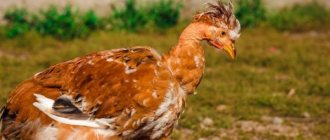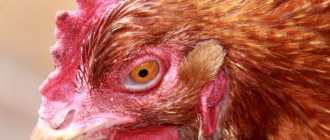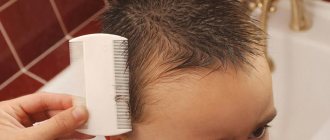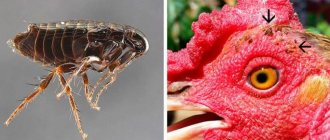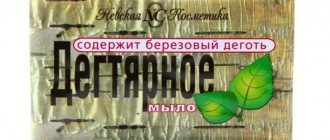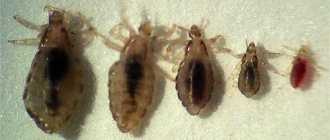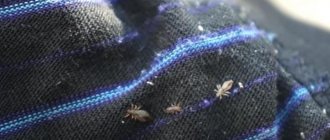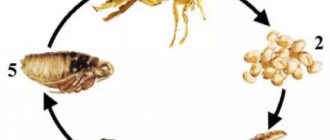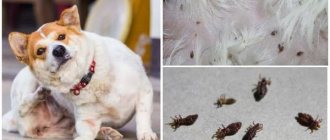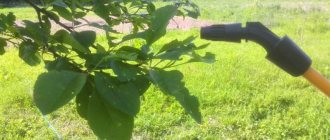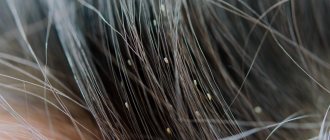Poultry owners know that members of the pheasant family often suffer from ectoparasites. In everyday life, these insects are known as chicken lice.
Chickens don't actually have lice. Parasites that live in bird feathers are feather eaters or lice eaters. These are two names for the same insect. Sometimes the names are compiled into “down-eater” or “feather-eater”.
What to do in such a situation? To get started, we recommend reading this article. This article describes in detail methods of controlling parasites. We also recommend that you consult a specialist. Read the article >>>
The difference between real lice and feather lice
Externally, the feather eater looks like a real louse, but these are representatives of two different orders with obvious differences:
- The feather eater's head is wider than the chest, the louse's is narrower;
- the oral apparatus of the pereater is of the gnawing type, while that of the louse is of the piercing-sucking type;
- the beetle eats dead skin particles and feather fibers, the louse drinks blood;
- The feather eater lives on birds, the louse on mammals.
There are similar features besides appearance. Both cause itching in the victim, and both live on the same host for their entire lives. They get rid of both with the same drugs.
Below is a photo of chicken lice - lice. And for comparison, a photo of a real head louse that parasitizes humans.
The belief that chicken lice live on humans is a myth. They can only accidentally fall on a person from the walls and ceiling of a heavily infested chicken coop or directly from a sick bird that was held in their hands.
In this case, lice do not live long. Until they fall to the ground, where they die of hunger. People are definitely not at risk of head lice after visiting an infested chicken coop.
Do other poultry such as turkeys and ducks have lice?
Small insects can infect other bird species besides chickens and roosters . Not only domestic turkeys, geese and ducks, but also sparrows and pigeons often become carriers of parasites.
Some types of chicken lice are able to migrate on the fur of rats. As a result of constant movement from one owner to another, it is necessary to take preventive measures for all poultry on the farm.
Symptoms of chicken disease
When the degree of infection is insignificant, fluff eaters practically do not make themselves felt: they do not affect the health, behavior and appearance of the carrier. But with intensive reproduction, the presence of parasites can be determined by the condition of the skin and plumage of chickens.
Typical symptoms of infection are:
- ruffled feathers;
- inflammation, redness, wounds, scratching on the skin;
- holes on individual feathers;
- necrosis and peeling of individual areas of the epidermis;
- partial loss of feathers;
- baldness in the anal area, on the head, neck, chest and abdomen;
- swelling of the eyelids, clouding of the cornea, purulent discharge from the eyes.
Infection with mallophages is evidenced by the restless behavior of chickens, which constantly scratch their beaks and paws, trying to remove insects from themselves. When parasites actively multiply, laying hens suffer loss of appetite, decreased body weight, and exhaustion, which negatively affects egg production.
Infected chickens suffer the infestation even more severely - they grow slowly, show no interest in food and practically do not gain weight. If treatment is not carried out in time, infection with mallophages will cause the death of the bird.
Pediculosis incidence peaks in autumn and spring.
The following factors contribute to infection and rapid reproduction of parasites:
- poor livestock care;
- unsanitary conditions;
- dampness in the chicken coop;
- poor diet;
- keeping a large number of chickens in a cramped poultry house;
- lack of free range;
- ignoring preventive measures.
Chicken lice can also appear after contact between birds and wild birds or rodents that carry ectoparasites.
Laying hens should be kept in direct sunlight or an incandescent lamp for 10-15 minutes if lice are suspected or for a routine examination. Mallophages love warmth, so they will certainly crawl closer to the light source and be clearly visible. In laying hens, you need to examine the skin under the feathers in the most vulnerable places where there is a concentration of down feather eaters: on the neck, cloaca, belly, and skin under the wings.
Can lice eaters parasitize humans?
Mallophages on the human body or head cannot exist and reproduce. Human skin is thicker than chicken skin, making it difficult for the parasite to bite through it to provide itself with food. In addition, the pest's paws are not able to firmly grasp the hair or epidermis, so the larvae or adults will be washed away during the first bath.
The danger of ectoparasites for people is that they are carriers of helminths and bacteria that cause severe infections. Pathogenic agents can enter the human body through a single bite.
Children and the elderly are at risk: since their top layer of skin is thinner than that of young and middle-aged people, it is easier for parasites to bite through it.
The likelihood of infection with worms, salmonellosis, encephalitis, brucellosis, spirochetosis, Newcastle disease and other dangerous diseases increases when eating meat and eggs of infected chickens.
Is it possible to eat meat from infected poultry?
Lice are carriers of severe infections and are often carriers of helminths. The eggs of the latter can get into poultry meat through abrasions or wounds.
To protect yourself from infection, you must avoid eating meat from sick poultry.
IMPORTANT. A similar warning applies to chicken eggs obtained from a sick chicken. Embryos may also contain pathogens and helminth eggs.
How to get rid of chicken lice in a chicken coop
If lice manage to infest a chicken coop, then all the birds living there will suffer. Taking this into account, treating the chicken coop for lice is mandatory. To eliminate parasites from the walls and floor of the chicken coop, it is recommended to use smoke bombs. There should be no birds in the area during processing.
The calculation of the product is as follows: 1 checker (50 g) per room of 250 cubic meters.
In addition, it is advisable to wash the entire chicken coop area with any pediculicidal solution. The walls should literally be bathed in an antiparasitic agent. In advanced conditions, it is recommended to burn the walls and floor with a blowtorch.
A week later, the treatment of the chicken coop must be repeated. After thorough treatment of the premises, they begin to remove lice from chickens.
How to treat chicks and chickens - treatment features?
If there is a risk of chickens becoming infected with lice, it is necessary to regularly disinfect the chicken coop with special means. Do not use drugs for adult birds.
It is allowed to treat chicks with synthetic compounds based on ethanol . Ethyl alcohol will help clean the skin of chickens from chicken lice. In this case, it is necessary to avoid getting the products into the eyes and beaks of young animals. It is necessary to wipe any smooth surfaces in the chicken coop with an alcohol solution.
In addition to ethanol, the following formulations can be used to treat chickens:
- solutions with sodium hypochlorite - the product cannot be abused , because the chemical has a destructive effect on epithelial cells;
- chlorhexidine;
- glutaraldehydes;
- iodine-based formulations;
- phenolic compounds.
The latter are characterized by a complete absence of odor. Such compositions can be used together with cold water. During chemical treatment, you should hold the beak and cover the eyes of the chicks with your fingers to prevent synthetic compounds from getting into the lungs, esophagus and organs of vision.
Otherwise, the chicken may die from its injuries or become completely blind.
Preparing your chicken coop to combat chicken lice
If pediculosis is detected in chickens, then you need to spend a lot of time to first clean the chicken coop and kill all the parasites. First of all, poultry farmers should thoroughly clean out chicken droppings and litter residues.
Feeders, drinkers and other items used by birds also need to be thoroughly washed. When washing, you should use disinfectants, and it is also advisable to pour boiling water over them to remove nits.
If there is a pen next to the chicken coop, then it would be correct to remove the top layer of soil on it and take it away from the chicken coop. And sand and ash can be poured into its original place.
Answers to popular questions
Inexperienced poultry keepers can be very confused when parasites appear in the area where the chickens are kept or on the birds themselves. Experienced veterinarians and farmers can tell you why lice appear and how to deal with them.
Where do lice come from?
The main reasons for the appearance of chicken lice:
- the coop room is too humid;
- litter is rarely removed from the chicken coop;
- chickens on dirty bedding get sick faster;
- the owners do not take good care of the chickens;
- the chicken coop is too small, cramped;
- the room where chickens are kept is never treated with disinfectants.
Sometimes lice appear even in clean and well-kept chicken coops. Sometimes they are brought there by foreign birds who want to profit from the feeder. Parasites from an infected bird spread to a healthy one, after which a dynamic process of reproduction in the feathers begins.
It is important to identify the pathological process at the initial stage, since advanced chicken lice is very difficult to treat.
Chicken coop treatment
Remember that parasites are not only on the birds themselves, but also in the chicken coop. Insects and their eggs can be found in the litter, corners, and crevices, so the livestock and the chicken coop are treated simultaneously.
When carrying out the procedure, you need to proceed in stages:
- First, each chicken is processed and they must be moved to another room. If it's a warm time of year, you can send them out for a walk.
- Absolutely all litter is cleaned out.
- Next, you need to use a rake to thoroughly stir up the litter, after which it is treated with an insecticidal agent, which is also applied to the floor and walls.
- Then you should wait several hours, after which all organic matter is removed from the house and burned. Pre-treatment of the litter is carried out so that the insects die, otherwise during transportation they will fall out throughout the area and will soon fall on the chickens again.
- At the last stage, it is necessary to process all the elements; wooden ones are scalded with boiling water, but metal ones can be burned with fire; for this, a blowtorch or gas burner is used.
Only after these steps can a new bedding be laid. To carry out disinfection, it is allowed to use chlorine-containing products, but when using them, the bird can be returned to the chicken coop only after the chlorine has completely evaporated.
Quite convenient to use are smoke bombs that use cypermethrin, which destroys lice, ticks and other parasites. Among the most popular are Fomor-Vet and Peshka-V, which are effective, easy to use, and low in cost. Approximate consumption for 80 - 100 cubic meters. is 30 - 50 g. Carbonation takes 2 hours, aeration takes only 1 hour.
Chemicals
To treat head lice in chickens, veterinary drugs are used that are intended for birds, as well as for dogs and cats. You can buy them in the form of sprays and drops. Let's look at the most popular drugs that are highly effective.
Frontline
An effective drug that is used not only against lice, but also ticks, lice eaters and other parasites. The action is carried out thanks to the main active substance - fipronil, which affects insects by contact. You can purchase it in two versions, bottles with a sprayer, and polyethylene pipettes.
This preparation uses three active substances at once, which enhance the effect of each other, due to which the treatment brings the most positive result. You can buy it in the form of a spray or pipettes, which are produced in doses.
Neostomazan
Unlike the previous insecticide, this one uses two active substances, they are known for their powerful effect on different types of parasites. It can be purchased in glass ampoules and is prepared in the form of an emulsion solution.
Before use, you need to prepare a working solution; for this, add 1 ml of emulsion to 1 liter of water. Suitable for processing poultry, chicken coops and all equipment.
Dana spray
This product is made using a very strong insectoacaricidal substance - permethrin. Affects lice, lice and ticks by contact-intestinal method. You can buy it in the form of a spray; the cylinders are very easy to use.
Perol-A
An analogue of permethrin is used here, only the synthetic version is a pyrethroid. Available in the form of a spray, aerosol, dropper bottles. Used for treating chickens, chicken coops and accessories.
Butox
A synthetic substance is also used - deltamethrin. You can purchase it in the form of a concentrated liquid, drops, aerosol, spray. A working solution should be prepared from the concentrated liquid; the proportions are indicated in the instructions for use; changing the proportions and dosages is prohibited.
Celandine
It is worth saying that this product is intended to combat parasites on cats and dogs, but it can also be used on birds. The composition contains fipronil and permethrin, two very powerful insecticides that show high effectiveness.
Foxim or Sebacil
These two drugs have the same active ingredients and also have the same mechanism of action. Before the procedure, you need to prepare a working solution, which is applied by spraying or spraying.
Arpalit-Neo
Used to treat head lice in birds. Contains 2 active components at once - permethrin and fenoxycarb. In addition to fast and effective treatment, the drug provides protection against re-infection.
During treatment, the drug is applied to the withers, in the area where the bird cannot reach it with its beak. Over the course of a day, the medicine penetrates the body and accumulates in the skin.
Before using any insecticide, be sure to study the instructions for use; all dosages and proportions when preparing the working solution must be observed; any correction is prohibited, since they are calculated in such a way as not to harm the animal.
In addition to the above solutions, sprays, drops, you can also purchase powder, which is no less effective in the fight against lice. For example, Deltamethrin powder, which has proven its high performance.
To treat a chicken coop you need about 50 - 150 g of powder, for 1 chicken about 10 - 15 g. An analogue of Insectal powder is no less effective. They are the same in composition, dosage and method of use.
All insecticides allow you to get rid of parasites at all stages of development. But it should be remembered that eggs, thanks to their shell, are resistant to aggressive substances. Therefore, the treatment may not destroy the eggs, resulting in mature eggs reappearing after a few days.
For this reason, it is recommended to repeat the procedures; about 2 - 3 treatments should be carried out, depending on the degree of infestation; it is imperative to maintain a time interval between procedures, at least 7 - 12 days.
Promectin, an oral drug that contains 1% ivermectin, also showed good results in the fight against lice. So, a solution is prepared from this substance, which is fed to the bird throughout the day. It is recommended to repeat after two weeks as a preventive measure. The advantage is that it is very easy to use.
Peredot: description of what it looks like
This tiny insect, 2 to 3 mm in size, settles on the body of poultry. Due to their rather small size, it is difficult to determine why poultry feathers fall out, pecking occurs, and the bird itself becomes restless.
So:
- Tiny parasites that live on the body of poultry are nothing more than “chicken lice”. The scientific name of the disease is mallophagosis, and small parasites are mallophages.
- These insects do not have wings, and the body has a flat, slightly elongated shape. The body is divided into segments. Insects lead a parasitic lifestyle.
- Dark stripes can be seen between the segments. The body is characterized by a light brown color with a yellow tint.
- To stay firmly on the insect's body, mallophages are armed with tenacious jaws and three pairs of legs. Parasites do not feed on the bird’s blood, but consume feathers and down, discharge from pecking wounds, and dead skin particles. For normal functioning of the parasite, a humidity of about 70-80% is needed, as well as a temperature of up to + 30 degrees.
- The eggs of the parasite can only be seen under a magnifying glass, since their size is no more than 1.5 mm. The female lays eggs on the feathers or down of the bird, after which, after 6-18 days, depending on the conditions, the larvae are born. Before becoming an adult mallophage, the larva molts 3 times. Each molt occurs after 12-18 days.
- The parasites are highly fertile, as the female lays 10 eggs every day.
- The parasite can live on the body of poultry for about 30 days, and outside the body - no more than 6 days. Mallophages spend almost all their time on the body of poultry.
Folk remedies
Of course, in addition to specialized insecticides, there are traditional methods that have been successfully used for many years. Let's look at the most popular and effective ones.
Kerosene
Kerosene is a fairly popular product that is used in the fight against lice not only on poultry, but also on people. It works as follows: upon contact with an insect, kerosene envelops it and blocks the respiratory tract, which leads to rapid death.
In addition, the aggressive substance partially dissolves the shell of the eggs, which contributes to the weakening of the offspring. During the procedure, each chicken is processed separately. Also, as a preventive measure, prepare a mixture of kerosene, benzene and ammonia, then apply a couple of drops to the withers.
Vinegar
For this recipe, regular 9% vinegar is used, from which the working solution is prepared. To do this, you need to dilute it with water in a ratio of 1: 2 or 1: 1. Next, the solution is poured into a spray bottle and the plumage is sprayed. It is also used to treat the chicken coop. This recipe shows the same effectiveness as kerosene.
Ash and sand baths
A very popular method of combating lice and other parasites that are found on the plumage and legs of laying hens. The advantage is that the application procedure is very easy, since the chickens take baths on their own.
For such baths, large basins, pallets, boxes, etc. are suitable. The following mixture is used as a filler, sand and hall are mixed in equal parts, then a little loamy soil and peat are added.
It is worth saying that folk recipes show good results if there are no more than 20 laying hens. If the livestock is large, 100 or more, it is certainly better to use specialized preparations.
Herbs and plants
Some herbs and plants have a fairly rich and pungent aroma, which parasites really don’t like; they try to leave the area where they smell them, mistaking them for danger.
Therefore, as a preventative measure, they can be used in chicken coops, these include:
- Tansy.
- Sagebrush.
- Chamomile.
- Rosemary.
- Ledum.
Since the odors will gradually disappear, the plants need to be replaced from time to time with freshly picked ones. These herbs are also natural insecticides and are often used in the form of decoctions.
You can prepare the following decoction:
- You need to take chamomile, wild rosemary and tansy, chop them and put them in a large saucepan.
- Pour 6 liters of boiling water over the herb, put on fire, bring to a boil and cook for 15 minutes.
- Next, the broth is cooled and filtered.
Use for treating poultry houses and all accessories.
Essential oils, which act on the same principle as aromatic herbs, have proven themselves to be effective. Eucalyptus or rosemary oil work well; you need to add a few drops to the water and spray the enclosure.
Another natural insecticide is Dalmatian chamomile, which can be purchased at pharmacies and is sold under the name Pyrethrum. This is a potent substance that destroys lice, fleas, and ticks in mammals and birds. In addition, it is effective against bedbugs, ants, cockroaches, etc.
How to fight: effective methods
The owners are faced with difficult tasks: to preserve adult birds and young birds, and to prevent the spread of parasitic infection to other chicken coops. Treatment of mallophagosis is a long, complex process: to completely destroy “chicken lice” it takes 3–4 months, often six months.
Veterinarians recommend a combination of synthetic drugs and formulations based on natural ingredients. The use of chemicals gives a noticeable effect, rather destroying parasites. Traditional methods are more effective for preventing infection and repelling parasites.
Drugs
Sick and healthy individuals are treated, and the premises must be disinfested. At the initial stage, it is difficult to determine which of the chickens is infected; the best way out is to use antiparasitic compounds to combat peri-eaters in all individuals.
The drugs are sold at a veterinary pharmacy. The doctor will select a remedy based on the symptoms and the degree of infection of poultry. Compositions against lice and ticks in domestic animals are suitable for the treatment of mallophagosis.
Effective poultry treatment products:
- Frontline.
- Stronghold.
- Celandine.
- Insectol.
- Arpalit.
Features of application:
close the beak or tie it, treat the back area with the selected insecticide
Particular attention: bald areas; the optimal distance for applying the spray is from 15 to 20 cm from the feathers; repeated treatment is carried out after a week: toxic compounds cause paralysis in adults, but have almost no effect on egg laying. Before this period, you should not spray or lubricate the backs of chickens/chickens: the birds may die;
To kill feather eaters in chickens, it is prohibited to use the drug in the form of a spray; spraying of the composition is carried out over all feathers, not only on the affected areas
If the treatment is not thorough enough, the parasites move to areas where the drug did not reach and develop further; Chemicals alone are not enough: the optimal result is achieved by combining sprays, anti-lice drops with home methods of fighting against lice.
Effective compositions for disinfestation of chicken coops:
- Cucaracha.
- Executioner.
- Tetrix.
- Battalion commander
- Dichlorvos.
For disinfestation of premises where hens and chicks are kept, preparations against fleas, cockroaches, ants, and bedbugs are suitable. The selection of the composition depends on the degree of infection of the chicken coop. If there is an abundance of parasites, drugs with a high degree of toxicity are required.
Processing rules:
put on a respirator, thick overalls, transparent plastic glasses, rubber gloves; prepare the working solution according to the instructions
Particular attention is paid to the concentration of the composition: many drugs show high effectiveness in a certain environment at an optimal concentration. The packaging of the drug indicates how many milliliters or grams of the product to dissolve in water for disinfection of premises; remove food, take out bowls and feed troughs, throw away wooden products where parasites or their eggs could be preserved; take out the litter, destroy (burn) or take it to a landfill; thoroughly clean the chicken coop from chicken droppings, leftover feed, and straw; treat perches, walls, floor with working solution
When using the composition in the form of a spray or aerosol, slowly go through every centimeter; for disinsection of a chicken coop, a solution prepared on the basis of an emulsion concentrate is preferable: the consumption of an aerosol or spray will be too large, several cans will be needed, which increases the cost of treatment against “chicken lice”; close the doors, wait until the vapors are absorbed into all the cracks; After a certain time, ventilate the room.
Folk remedies
Effective agents for the treatment of mallophagosis:
- baths made of wood ash and sand. A simple way to get rid of parasites, especially before there are too many of them. Combine ash and clean sand, pour into a trough, place in a chicken coop or in an aviary (depending on the time of year). Chickens happily “bathe” in the dust, feather eaters suffocate and quickly die under the layer enveloping their feathers;
- use of medicinal plants. Prepare a strong infusion of chamomile (take 4 tablespoons of dried flowers for 1 liter of water), boil for 5 minutes, drain, rub into the feathers and skin of adult hens and chickens. Powder made from twigs, leaves of wormwood and pyrethrum (a type of chamomile) repels parasites.
Preventive actions
Of course, 100% protection does not exist, but preventive measures can significantly reduce risks, these include:
- Containers are placed in the chicken coop into which a mixture of sand and ash is poured. Also remember that laying hens should be able to take dust baths.
- Enclosures must be protected from rodents to exclude any possibility of rats and mice entering.
- You should also ensure that there is no contact with wild birds, which often cause infection.
- Regular cleaning, replacement of bedding is mandatory, air humidity must be monitored, and cleaning should also be carried out in nearby areas.
- It is recommended to carry out preventive antiparasitic treatment 1, 2 times a year.
- Feeders and drinkers are washed and disinfected daily.
- You should be careful when visiting other poultry houses; be sure to change clothes and shoes after such visits.
- Preventive examinations are carried out; if an infection is detected in at least one laying hen, the entire flock is treated.
- The bird’s immune system should be strengthened; for this purpose, special fortified bait is given in autumn and winter.
- It is necessary to first treat purchased laying hens with an antiparasitic agent, and only then place them with the others.
As you can see, chicken lice can cause huge problems, so it is easier to prevent this situation than to deal with it later. If an infestation is detected, measures must be taken immediately, preventing parasites from multiplying.
Prevention of insects
As mentioned above, it is much easier to prevent lice than to fight them. The main preventive measures are as follows:
- provide protection from rodents: seal cracks and holes in the chicken coop, and if necessary, add rat poison in a place inaccessible to chickens;
- Clean the chicken coop regularly (take out trash, old bedding, etc.);
- frequently inspect your chickens for lice;
- hang dry wormwood or lavender indoors to repel parasites;
- ensure complete absence of contact with other people's chickens while out on the run (for this you can use pens covered with mesh).
To summarize, it should be said that timely prevention of lice will not only help maintain the health of the chicken, but will also protect you from contracting dangerous diseases. Clean the chicken coop in a timely manner, because a bird that lives in a clean environment is a healthy bird.
It is possible to defeat parasites!
Antiparasitic Complex® - Reliable and safe removal of parasites in 21 days!
- The composition includes only natural ingredients;
- Does not cause side effects;
- Absolutely safe;
- Protects the liver, heart, lungs, stomach, skin from parasites;
- Removes waste products of parasites from the body.
- Effectively destroys most types of helminths in 21 days.
There is now a preferential program for free packaging. Read expert opinion.
Read further:
Sanitation for pediculosis: algorithm for treating the patient and the room
Domestic insect parasites: photos and names, control methods
Thiabendazole: instructions for use, active ingredient, price and analogues
No to ticks: where to order insect repellent treatment?
Insects parasites of humans and animals: types, description and methods of control
Ointments for the treatment of staphylococcus: popular means for treating the disease
